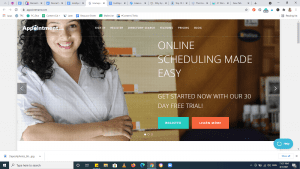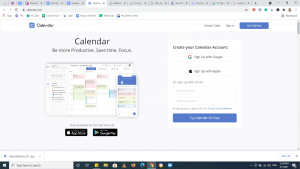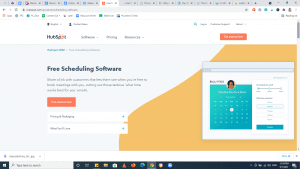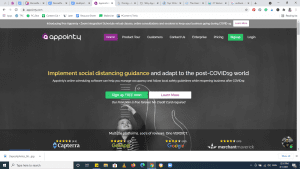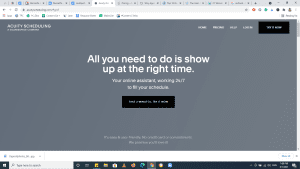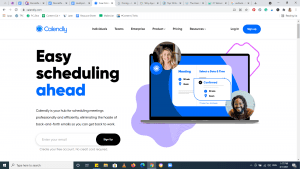
The global pandemic seems to be abating — but the wind has kicked up some dust. I was cooped up at home all last weekend. I decided to make the best of it by getting a jump on my upcoming week. You know, laundry, meal prep, tend the kids — and planning my schedule.
I hate it if I allow my laptop to become a filthy, disorganized mess. Why did I let this happen? My best advice is — DON’T be a digital hoarder.
The term “digital-hoarding” was first used in 2015. Specifically, it was regarding a 47-year-old man who snapped an astonishing 1,000 digital photographs every day!
“He never used or looked at the pictures he had saved but was convinced that they would be of use in the future,” wrote the authors of a case study published in the British Medical Journal. They went on to define this phenomenon as “the accumulation of digital files to the point of loss of perspective which eventually results in stress and disorganization.”
In a follow-up study, researchers went on to identify four types of digital hoarders.
“‘Collectors’ are organized, systematic, and in control of their data,” explains one of the researchers Nick Neave, Associate Professor in Psychology, and Director of the Hoarding Research Group, Northumbria University, Newcastle “‘Accidental hoarders’ are disorganized, don’t know what they have, and don’t have control over it.”
“The ‘hoarder by instruction’ keeps data on behalf of their company (even when they could delete much of it),” Neave adds. “Finally, ‘anxious hoarders’ have strong emotional ties to their data — and are worried about deleting it.”
Why is digital hoarding a problem?
Digital hoarding more not seems like much of an issue. What’s the big deal if you have thousands of photos stored on your hard drive? Is it really so bad that you have an arsenal of tools that make work more efficient?
In reality, this can make you anxious and feel overwhelmed. It’s also distracting. And, it can lead to information overload, which depletes your energy.
It’s like when you have a sink full of dirty dishes or a desk with a mountain of papers. It’s difficult to focus on anything else when you’re surrounded by clutter. And, it’s exhausting to keep with emails, Instagram pics, Slack messages, and trying to find a research paper you wrote back in college.
Digital clutter interferes with your mental health and robs you of greater productivity.
As I realized over the weekend, digital clutter slows down your computer. That’s not just annoying. It can also waste your valuable time.
Moreover, “the more data is kept, the greater the risk that a cyberattack could lead to the loss or theft of information covered by data protection legislation,” states Neave. “In the EU, new GDPR rules mean companies that lose customer data to hacking could be hit with hefty fines.”
“The final consequence of digital hoarding — in the home or at work — is an environmental one,” he adds. “Hoarded data has to be stored somewhere. The reluctance to have a digital clear-out can contribute to the development of increasingly large servers that use considerable amounts of energy to cool and maintain them.”
Ways to become a digital minimalist.
While I don’t think that my digital hoarding had gotten that out of control, it was clear that I needed to do a little housekeeping. Thankfully, this doesn’t have to be an overwhelming process. In fact, here are ten easy ways you can avoid becoming a digital hoarder.
1. Get your inbox in check.
I know a lot of people who neglect their inboxes. Eventually, they have thousands of unread messages. Besides potentially missing an important email, this creates a cycle where they are so overwhelmed they continue to let this happen.
Right now, go through and clean out your inbox. Just breathe; you’ll feel better when it’s done. Afterward, you can prevent this from happening again by keeping your email in check;
- Setting up rules, filters, and labels. It’s a simple way to keep your inbox organized by separating messages.
- Use Unroll.me or Sanebox to unsubscribe from lists.
- Block out specific times to check your inbox.
- If you have multiple accounts, unify them so that you only have to go through one.
- Instead of lengthy threads, use other communication mediums like phone calls, texts, or Slack messages.
2. Keep your desktop as minimal as possible.
Are you old enough to remember Windows 95? I do. I remember most of how littered it was with icons — many of which were free trials or programs I’d never use.
Thankfully, that’s a problem from the past. You can quickly access programs and files through a menu like Launcher (Chrome), Start (Windows), and Launchpad (Mac). That means that there’s really no reason to have distracting icons and shortcuts on your desktop.
Personally, my desktop is icon-free. And, it’s been a game-changer. My laptop looks so fresh and clean.
What about the programs you use the most? They are conventionally located in your taskbar at the bottom of your screen.
Also, use a minimalist background. It’s a simple way to prevent your eyes from facing the negative effects of digital clutter.
3. Break up with old files.
It’s hard to part ways with documents, photos, videos, or whatever else you’ve downloaded. But, if you go through all of your old files, I guarantee that you can delete a bulk of them without losing a moment of sleep.
At the same time, I do understand that this can make you anxious. So, start nice and slow. And I would begin with deleting all duplicate files.
From there, I would tackle the oldest documents. In most cases, I doubt you need to hold onto a digital file from several years ago. But, if you feel that you do, organize them and store them on an external hard drive.
4. Use cleanup tools.
I use CCleaner. While I didn’t do this for a while, it will eliminate cookies and your browsing history. It can also clear your cache and downloads. You can also try similar tools like;
- MyCleanPC
- CleanMyMac X Tool
- Disk Cleanup Pro Tool
- MacKeeper Tool
You don’t have to use these tools. I feel that it’s more convenient since it’s conveniently located next to my browser.
Also, CCleaner can be useful to detect “bloatware.” Also known as “crapware,” this is unuseful software that’s been preinstalled or that you unknowingly downloaded and installed. And it can impact the performance of your device.
Other tools that you can use to address bloatware are Clario and Should I Remove It? However, to do this right, you need to remove “bloatware” manually. If you don’t know how to do this, ZDNet has an article on how to do so if you’re using Windows 10.
Bonus tip: Delete bookmarks that you no longer need. For the ones that you do want to save, move them over to Evernote or Pocket.
5. Uninstall old apps and programs.
Remember when you made your desktop a minimalists utopia? Well, just because you deleted icons doesn’t mean that you completely uninstalled the apps or programs you no longer want. To get rid of them for good, you need to uninstall them.
The process will depend on the device you’re using. For example, it can be complicated if you’re using Windows 10. As such, head over to PCMag for advice on how to do this. It’s more straightforward if you’re using a Chromebook or Mac.
6. Be less social.
I’m going to be 100% upfront—I’m over social media, but we likely have to use this media for business. These platforms can be useful to network, spread brand awareness, and keep in touch with friends and family — just watch that they’re not destructive to you or you’re productivity.
On average, we spend 145 minutes per day on social media. Considering that social media feel increasingly toxic and can negatively impact our mental health, don’t you think that time could be spent elsewhere? Even if you don’t feel that exact way, it’s still distracting.
While not everyone can permanently delete social media, at least cut back on the accounts, you use. If you never go on Pinterest, then go ahead and delete your account. You should also defriend and unfollow people who are negative and only make you angry.
You can also reduce the time spent on social by;
- Removing the apps from your smartphone so that you have to log in on the browser.
- Using social media and monitoring tools like Hootsuite or Sprout Social.
- Block social media apps and sites at specific times.
- Set time limits on how long you’ll be on social.
- Use batching to check your channels only three times per day; before work, around lunch, and before ending the workday.
7. Cut back on the passwords.
According to a study commissioned by NordPass, the average person has 100 different passwords across various sites and services. The study states that there’s been an across as more people have searched for new services and entertainment during the pandemic.
Trying to remember all of these different passwords is no easy feat. But, using a password manager like LastPass, Dashlane, or 1Password will securely remember these passwords for you.
I’d also recommend that you go through and delete rarely used accounts. Dormant accounts can cause security risks. You’ll also receive less junk mail.
JustDeleteMe is a directory of the most frequently used sites and how difficult it is to delete your account.
8. Free up space through defragging.
If your computer is really dragging, then you’ll probably need to defrag it to free up space. Most computers do this automatically. But, if not, you’ll want to create a calendar reminder to do this regularly. Or, you could use a took like Disk Space Fan.
Again, each OS is different. Here are some resources you can turn to if you still have trouble freeing up space;
- Ways to improve your computer’s performance
- Defragment your Windows 10 PC
- Free up space on your Chromebook
- Do You Need to Defragment a Mac’s Hard Drive?
9. Don’t forget about your smartphone.
Digital clutter doesn’t just involve your laptop or PC. It can also spill over to your smartphone.
Most of the tips listed above can also be applied to your smartphone. But here are some pointers you can use to clean digital clutter on your phone.
- Deleting unused apps from your device.
- Moving apps that are frequently used from your home screen or placing them in “drawers.”
- Organizing apps by tasks, usage, or emojis.
- As opposed to saving files, use streaming services.
- Go through your photos and delete the ones that you would never share. As for the ones you want to keep, back them up and delete them from your phone.
10. Clean up your online calendar.
Your calendar app may not be eating too much digital space. But, if it’s jam-packed, how exactly will you squeeze in the time to handle your digital clutter? Besides, when you’re calendar is lean and mean, you’ll have more flexibility in your schedule — as well as enjoy your leisure time.
- Clean your calendar by removing unnecessary events.
- Sync your calendars so that they can be accessed from one place.
- Use color-coding so that you can quickly distinguish entries.
- Leave meetings without a purpose and back-to-back appointments off. The same goes for checklists, notes, and minuscule tasks.
- Use tools like Calendar to make smart suggestions on why you can best schedule your time.
Final words of advice.
It’s easy to let digital clutter build up over time. However, if you let it get out of control, it can affect your device’s performance, productivity, and health. At the same time, it’s not the most exciting chore; set aside a couple of minutes each week to keep up against the fight against digital clutter.





